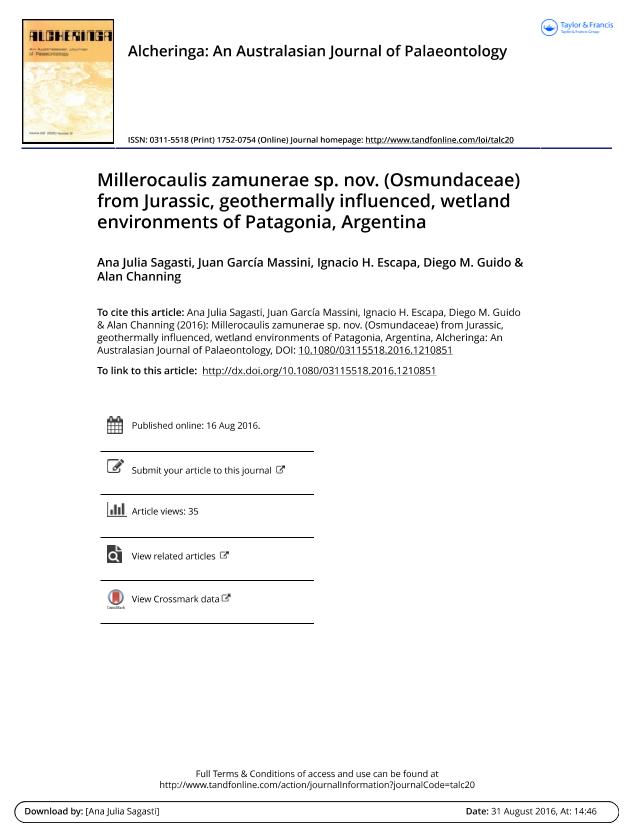Artículo
Millerocaulis zamunerae sp. nov. (Osmundaceae) from Jurassic, geothermally influenced, wetland environments of Patagonia, Argentina
Sagasti, Ana Julia ; García Massini, Juan Leandro
; García Massini, Juan Leandro ; Escapa, Ignacio Hernán
; Escapa, Ignacio Hernán ; Guido, Diego Martin
; Guido, Diego Martin ; Channing, Alan Ernest
; Channing, Alan Ernest
 ; García Massini, Juan Leandro
; García Massini, Juan Leandro ; Escapa, Ignacio Hernán
; Escapa, Ignacio Hernán ; Guido, Diego Martin
; Guido, Diego Martin ; Channing, Alan Ernest
; Channing, Alan Ernest
Fecha de publicación:
08/2016
Editorial:
Taylor & Francis Ltd
Revista:
Alcheringa
ISSN:
0311-5518
Idioma:
Inglés
Tipo de recurso:
Artículo publicado
Clasificación temática:
Resumen
A new species of Millerocaulis Erasmus ex. Tidwell emend. Vera is defined based on several permineralized stems recovered from geothermally influenced chert deposits in the Middle–Late Jurassic La Matilde Formation (Santa Cruz, Argentina). Millerocaulis zamunerae sp. nov. is characterized by the presence of an ectophloic dictyoxylic siphonostele, inner parenchymatic and outer sclerotic cortices, homogeneous sclerotic ring in the petiole bases, two masses of sclerenchyma lining the concavity of the petiolar vascular bundle, petiolar inner cortex with sclerenchyma strands in the outermost petiole cycles and stipular wings having one large and several smaller sclerenchyma bundles. Millerocaulis zamunerae inhabited geothermal wetlands and other hot-spring-related sedimentary facies associated with the La Bajada epithermal deposit. Reference to active geothermal wetlands, analogous living plants and other fossil hot spring ecosystems suggest the plant’s tolerance of physico-chemical stressors including elevated temperature, pH, salinity and phytotoxic metals/metalloids. Millerocaulis zamunerae thrived in wetlands preserved in the Jurassic geothermal systems of Santa Cruz Province, the same kind of environment in which Equisetum thermale Channing et al. was recorded previously.
Archivos asociados
Licencia
Identificadores
Colecciones
Articulos(CCT - LA PLATA)
Articulos de CTRO.CIENTIFICO TECNOL.CONICET - LA PLATA
Articulos de CTRO.CIENTIFICO TECNOL.CONICET - LA PLATA
Articulos(CRILAR)
Articulos de CENTRO REGIONAL DE INV. CIENTIFICAS Y TRANSFERENCIA TECNOLOGICA DE ANILLACO
Articulos de CENTRO REGIONAL DE INV. CIENTIFICAS Y TRANSFERENCIA TECNOLOGICA DE ANILLACO
Citación
Sagasti, Ana Julia; García Massini, Juan Leandro; Escapa, Ignacio Hernán; Guido, Diego Martin; Channing, Alan Ernest; Millerocaulis zamunerae sp. nov. (Osmundaceae) from Jurassic, geothermally influenced, wetland environments of Patagonia, Argentina; Taylor & Francis Ltd; Alcheringa; 40; 4; 8-2016; 456-474
Compartir
Altmétricas



